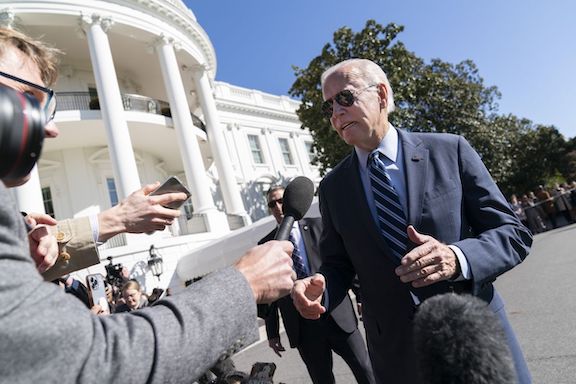In September, the White House announced that the federal government will prioritize the purchase of low-carbon materials for federal construction projects. That is likely to benefit the steel industry in the United States, which produces steel with a lower carbon footprint than some international alternatives.

Globally, the steel industry, which produces 1.9 billion metric tons of crude steel annually, is responsible for 3.7 gigatons of direct and indirect carbon dioxide emissions, or 10% of the total, mostly by using blast furnaces that burn coal to produce iron and steel. Most domestic steelmakers use electric arc furnaces (EAF) to process recycled steel, accounting for the lower emissions. Decarbonization efforts are ongoing for the steel industry globally, and further innovations, such as using hydrogen as a steelmaking fuel and refining iron ore electrochemically, are on the horizon and could be competitive with EAF technology.
Inflation Reduction Act
The Inflation Reduction Act, which passed Congress and was signed by President Joe Biden over the summer, provided $4.5 billion in funding to the General Services Administration, the Department of Transportation, and the Environmental Protection Agency to designate and use construction materials and products that produce lower levels of greenhouse gas emissions (GHG). Besides steel, the Buy Clean program will also impact federal buying of concrete, asphalt, and glass, and additional construction materials and pollutants are likely to be included going forward.
Buy Clean will favor federal steel procurement from domestic manufacturers, according to Kevin Dempsey, CEO of the American Iron and Steel Institute. “Of the major steel-producing countries, the U.S. has the lowest CO emissions per ton of steel produced,” he said.
Seventy percent of U.S. steelmaking uses EAF, processing recycled steel with electricity in a one-step process. Traditional, or blast furnaces, steelmakers, by contrast, which represent 70% of global output, manufacture steel by using coking coal to melt ore into iron and then process that into steel.
A recent study undertaken by CRU Group, a business intelligence firm specializing in metals manufacturing, found that greenhouse gas emissions from EAF steelmaking were dramatically lower than from blast furnaces, 75% lower in emissions intensity at the crude and hot-rolled phases at Scope 1 and Scope 2. Scope 1 refers to direct emissions, such as those made by running boilers and vehicles, while Scope 2 emissions are indirect, such as those produced by the electricity or energy used to heat and cool buildings.
At the crude steelmaking phase, the study concluded, average Scope 1 and 2 emissions for EAF steelmakers averaged .37 metric tons of carbon dioxide per metric ton of crude steel, while traditional steelmakers averaged 1.67. At the hot-rolled steelmaking phase, EAF steelmakers in the U.S. average .48 metric tons of CO per metric ton of hot-rolled steel, versus 1.94 for traditional steelmakers.
EAF Technology
The “study validates that using EAF technology is the most sustainable means of producing steel,” said Philip Bell, president of the Steel Manufacturers Association, which represents EAF producers.
While EAF technology has been around for decades, there are other efforts now underway that may represent future decarbonization alternatives. The German steelmaker Salzgitter announced in October that it wrapped up what it called a successful trial for hydrogen and steel production with high-temperature electrolysis.
The trial produced 100 tons of hydrogen by using industrial waste heat and renewable electricity to split steam into hydrogen and oxygen. Salzgitter will use hydrogen for carbon-neutral steel production beginning in 2025.
“Hydrogen reduces carbon emissions very efficiently,” said Alexander Redenius, a Salzgitter executive. The trial provided “valuable insights into the integration of electrolysis into our production processes.” He added, however, that “availability and cost-effectiveness are becoming increasingly important” issues when it comes to “the transformation of steel production towards hydrogen-based processes.”
Those considerations and others are being addressed by innovations that would eliminate emissions from the iron-ore conversion process, which accounts for 90% of steelmaking emissions for manufacturers that use iron ore as a raw material. Electra, a company based in Boulder, Colorado, announced in October that it had raised $85 million to produce low-temperature iron from low-grade ores using intermittent electricity technology.
Electra’s process refines iron ore using renewable electricity into pure iron at 60 degrees Celsius, as compared to the 1,600 degrees used in blast furnaces. The iron is then converted to steel using existing EAF infrastructure. Electra says its process overcomes two challenges for the steel industry: the projected future shortage of higher-grade iron ores and hydrogen steelmaking’s requirement for ore with an iron content of 67% or above.
“Electra’s process intakes ores with iron content as low as 35%,” said Sandeep Nijhawan, the company’s CEO. “Our electrochemical process refines iron ore at a lower process temperature, replacing coal with intermittent renewable energy, and displacing commercial ores with lower-grade ores that are currently treated as waste.” Electra will complete a pilot green-iron refining plant in 2023 in Boulder and plans to have a commercial-scale demonstration plant qualified by around 2026.
Because of the steel industry’s outsized contributions to emissions, decarbonizing the industry on a global scale is regarded as critical to achieving the Paris Agreement’s goal of limiting warming to 1.5 degrees Celsius. That accounts for the new investments in green steelmaking, which will likely be further incentivized by the U.S. government’s requirements for low-carbon steel. Considering that hydrogen-based and other innovations are still years from being commercialized, and as long as Buy Clean doesn’t include a catalog of waivers and exemptions as is found in other government programs, domestic producers will likely benefit from the Biden administration’s policy—at least for the time being.




